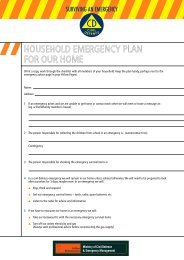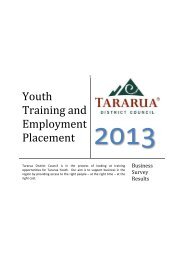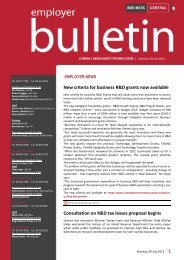Food Control Plan Checklist - Tararua District Council
Food Control Plan Checklist - Tararua District Council
Food Control Plan Checklist - Tararua District Council
- No tags were found...
Create successful ePaper yourself
Turn your PDF publications into a flip-book with our unique Google optimized e-Paper software.
The Basics<strong>Food</strong> allergens1 Goal 2 Why?To provide customers with accurate information on whethera food contains specific allergens, or could have traces of anallergen from cross-contact.• Customers must be able to make informed choices aboutthe food they, and people in their care, eat.• <strong>Food</strong> allergies can result in life threatening reactions whichaffect the whole body, often within minutes of eating thefood.3 How this is doneIf you are told by a customer that they suffer fromallergies, talk to them about what menu items maybe appropriate for them to order. If you are notconfident that you can produce for them safely,don’t. It is better for them to eat elsewhere thanrisk an allergic reactionCommon allergens<strong>Food</strong>s that most frequently cause allergic reactionsinclude cereals, shellfish, eggs, fish, milk, nuts,sesame seeds, peanuts, soybeans, sulphites, wheatand bee products such as royal jelly, pollen andpropolis. These foods are responsible for over 90%of serious reactions.4 What if there is a problem?If you think a customer is having a severe allergic reaction:• immediately ring 111 and ask for an ambulance with aparamedic straight away• immediately explain that your customer could be having anallergic reaction.Identify what led to the customer’s allergic reaction.Review ingredient labels and recipes to ensure all allergens areknown.Review the way staff prepare a dish for someone with a foodallergy; make changes as appropriate.Retrain staff to ensure that they understand how important itis to provide accurate information to food-allergic customers.If a customer tells us that they have a food allergy thefollowing staff member is told:head chefday-to-day managerotherThe person identified above is responsible for providinginformation to the customer on what allergens could bepresent in the food.Know what’s in the foodSomeone who has a food allergy needs to know the exactingredients of the food that they eat.• Be aware that of all ingredients used in the food to beserved to customers with a food allergy.• Check whether ingredients are free from the allergen• Check all the ingredients in the dish, as well as what isused to cook the dish (eg, oils etc) as well as sauces andgarnishes served with the dish.5Write it downKeep details of the ingredients (and whatthey contain) for all dishes and prepackagedfood to be served to customerswith a food-related allergy.Write down in the Diary any action takenin the event that someone has an allergicreaction.If there is any doubt about whether a foodcontains even a small amount of an allergen, tellthe customer – never guess!Avoid cross-contactMake sure food doesn’t get contaminated with small amountsof an allergen from surfaces, utensils and equipment that hasbeen used to prefer other foods.• Ensure that clothing is clean and thoroughly wash yourhands (see Hand hygiene).• Prepare food containing different allergens in separateareas using separate equipment and utensils. If this is notpossible, then thoroughly clean all equipment and utensilsto be used prior to preparing the food.• Do not fry food in oil that has previously been used to fryfood containing an allergen.<strong>Food</strong> <strong>Control</strong> <strong>Plan</strong> Version 3.0 2011B7







